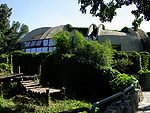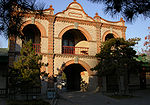
Beijing Zoo
Encyclopedia


Beijing
Beijing , also known as Peking , is the capital of the People's Republic of China and one of the most populous cities in the world, with a population of 19,612,368 as of 2010. The city is the country's political, cultural, and educational center, and home to the headquarters for most of China's...
, China
China
Chinese civilization may refer to:* China for more general discussion of the country.* Chinese culture* Greater China, the transnational community of ethnic Chinese.* History of China* Sinosphere, the area historically affected by Chinese culture...
. Located in the Xicheng District
Xicheng District
Xicheng District is a district in Beijing, China. Xicheng District spans 32 square kilometres, making it the largest portion of the old city , and has 706,691 inhabitants . Its postal code is 100032. Xicheng is subdivided into 15 subdistricts of the city proper of Beijing...
, the zoo occupies an area of 89 hectares (219 acres), including 5.6 hectares of lakes and ponds (13.8 acres). It is one of the oldest zoos in China and has one of the largest animal collections in the country. The zoo and its aquarium has over 450 species of land animals and over 500 species of marine animals. In all, it is home to 14,500 animals. More than six million visitors come to the zoo each year. The zoo was founded in 1906 during the late Qing Dynasty
Qing Dynasty
The Qing Dynasty was the last dynasty of China, ruling from 1644 to 1912 with a brief, abortive restoration in 1917. It was preceded by the Ming Dynasty and followed by the Republic of China....
. Like many of Beijing's parks, the zoo's grounds resemble classical Chinese gardens, with flower beds amidst natural scenery, including dense groves of trees, stretches of meadows, small streams and rivers, lotus pools and hills dotted with pavilions and historical buildings.
The Beijing Zoo is best known for its collection of rare animals endemic to China including the Giant Panda
Giant Panda
The giant panda, or panda is a bear native to central-western and south western China. It is easily recognized by its large, distinctive black patches around the eyes, over the ears, and across its round body. Though it belongs to the order Carnivora, the panda's diet is 99% bamboo...
s, which are zoo's most popular animals, the golden snub-nosed monkey
Snub-nosed monkey
Snub-nosed monkeys are a group of Old World monkeys and make up the entirety of the genus Rhinopithecus. The genus occurs rarely and needs much more research...
, South China Tiger
South China Tiger
The South China tiger is a tiger subspecies that originated in southern China and northern Indochina and has been classified as critically endangered by IUCN since 1996 as it is possibly extinct in the wild....
, white-lipped deer, Pere David's Deer
Père David's Deer
Père David's Deer, Elaphurus davidianus, also known as the Milu , is a species of deer known only in captivity. It prefers marshland, and is believed to be native to the subtropics of China. It grazes on a mixture of grass and water plants. It is the only extant member of the genus Elaphurus...
, crested ibis
Crested Ibis
The Crested Ibis , also known as the Japanese Crested Ibis or Toki , is a large , white-plumaged ibis of pine forests. Its head is partially bare, showing red skin, and it has a dense crest of white plumes on the nape. This species is the only member of the genus Nipponia.Their habitat is usually...
, Chinese Alligator
Chinese Alligator
The Chinese alligator or Alligator Alligator sinensis) is one of two known living species of Alligator, a genus in the family Alligatoridae. The Chinese alligator is native only to China...
and the Chinese Giant Salamander
Chinese giant salamander
The Chinese giant salamander is the largest salamander in the world, reaching a length of 180 cm , although it rarely – if ever – reaches that size today...
. Other endangered or threatened species include Siberian tiger, yak
Yak
The yak, Bos grunniens or Bos mutus, is a long-haired bovine found throughout the Himalayan region of south Central Asia, the Tibetan Plateau and as far north as Mongolia and Russia. In addition to a large domestic population, there is a small, vulnerable wild yak population...
, Przewalski's horse
Przewalski's Horse
Przewalski's Horse or Dzungarian Horse, is a rare and endangered subspecies of wild horse native to the steppes of central Asia, specifically China and Mongolia.At one time extinct in the wild, it has been reintroduced to its native habitat in Mongolia at the Khustain Nuruu...
, snow leopard
Snow Leopard
The snow leopard is a moderately large cat native to the mountain ranges of South Asia and Central Asia...
, Tibetan gazelle
Goa
Goa , a former Portuguese colony, is India's smallest state by area and the fourth smallest by population. Located in South West India in the region known as the Konkan, it is bounded by the state of Maharashtra to the north, and by Karnataka to the east and south, while the Arabian Sea forms its...
, and kiang
Kiang
The kiang is the largest of the wild asses. It is native to the Tibetan Plateau, where it inhabits montane and alpine grasslands. Its current range is restricted to Ladakh in Jammu and Kashmir, plains of the Tibetan plateau and northern Nepal along the Tibetan border...
. The zoo also has a broad collection of megafauna
Megafauna
In terrestrial zoology, megafauna are "giant", "very large" or "large" animals. The most common thresholds used are or...
such as lion
Lion
The lion is one of the four big cats in the genus Panthera, and a member of the family Felidae. With some males exceeding 250 kg in weight, it is the second-largest living cat after the tiger...
, jaguar
Jaguar
The jaguar is a big cat, a feline in the Panthera genus, and is the only Panthera species found in the Americas. The jaguar is the third-largest feline after the tiger and the lion, and the largest in the Western Hemisphere. The jaguar's present range extends from Southern United States and Mexico...
, clouded leopard
Clouded Leopard
The clouded leopard is a felid found from the Himalayan foothills through mainland Southeast Asia into China, and has been classified as vulnerable in 2008 by IUCN...
, Asian
Asian Elephant
The Asian or Asiatic elephant is the only living species of the genus Elephas and distributed in Southeast Asia from India in the west to Borneo in the east. Three subspecies are recognized — Elephas maximus maximus from Sri Lanka, the Indian elephant or E. m. indicus from mainland Asia, and E. m....
and African elephant, rhinoceros
Rhinoceros
Rhinoceros , also known as rhino, is a group of five extant species of odd-toed ungulates in the family Rhinocerotidae. Two of these species are native to Africa and three to southern Asia....
, hippopotamus
Hippopotamus
The hippopotamus , or hippo, from the ancient Greek for "river horse" , is a large, mostly herbivorous mammal in sub-Saharan Africa, and one of only two extant species in the family Hippopotamidae After the elephant and rhinoceros, the hippopotamus is the third largest land mammal and the heaviest...
, black bear, polar bear
Polar Bear
The polar bear is a bear native largely within the Arctic Circle encompassing the Arctic Ocean, its surrounding seas and surrounding land masses. It is the world's largest land carnivore and also the largest bear, together with the omnivorous Kodiak Bear, which is approximately the same size...
, tapir
Tapir
A Tapir is a large browsing mammal, similar in shape to a pig, with a short, prehensile snout. Tapirs inhabit jungle and forest regions of South America, Central America, and Southeast Asia. There are four species of Tapirs: the Brazilian Tapir, the Malayan Tapir, Baird's Tapir and the Mountain...
, sea turtle
Sea turtle
Sea turtles are marine reptiles that inhabit all of the world's oceans except the Arctic.-Distribution:...
, penguin
Penguin
Penguins are a group of aquatic, flightless birds living almost exclusively in the southern hemisphere, especially in Antarctica. Highly adapted for life in the water, penguins have countershaded dark and white plumage, and their wings have become flippers...
, gorilla
Gorilla
Gorillas are the largest extant species of primates. They are ground-dwelling, predominantly herbivorous apes that inhabit the forests of central Africa. Gorillas are divided into two species and either four or five subspecies...
, chimpanzee
Chimpanzee
Chimpanzee, sometimes colloquially chimp, is the common name for the two extant species of ape in the genus Pan. The Congo River forms the boundary between the native habitat of the two species:...
, kangaroo
Kangaroo
A kangaroo is a marsupial from the family Macropodidae . In common use the term is used to describe the largest species from this family, especially those of the genus Macropus, Red Kangaroo, Antilopine Kangaroo, Eastern Grey Kangaroo and Western Grey Kangaroo. Kangaroos are endemic to the country...
, muntjac
Muntjac
Muntjac, also known as Barking Deer and Mastreani Deer, are small deer of the genus Muntiacus. Muntjac are the oldest known deer, appearing 15–35 million years ago, with remains found in Miocene deposits in France, Germany and Poland....
, addax
Addax
The Addax , also known as the screwhorn antelope, is a critically endangered species of antelope that lives in the Sahara desert. As suggested by its alternative name, this pale antelope has long, twisted horns. It is closely related to the oryx, but differs from other antelopes by having large...
, zebra
Zebra
Zebras are several species of African equids united by their distinctive black and white stripes. Their stripes come in different patterns unique to each individual. They are generally social animals that live in small harems to large herds...
, otter
Otter
The Otters are twelve species of semi-aquatic mammals which feed on fish and shellfish, and also other invertebrates, amphibians, birds and small mammals....
, bat
Bat
Bats are mammals of the order Chiroptera "hand" and pteron "wing") whose forelimbs form webbed wings, making them the only mammals naturally capable of true and sustained flight. By contrast, other mammals said to fly, such as flying squirrels, gliding possums, and colugos, glide rather than fly,...
, flamingo
Flamingo
Flamingos or flamingoes are gregarious wading birds in the genus Phoenicopterus , the only genus in the family Phoenicopteridae...
and lemur
Lemur
Lemurs are a clade of strepsirrhine primates endemic to the island of Madagascar. They are named after the lemures of Roman mythology due to the ghostly vocalizations, reflective eyes, and the nocturnal habits of some species...
. The Beijing Zoo has 13 of the world's 15 species of cranes
Crane (bird)
Cranes are a family, Gruidae, of large, long-legged and long-necked birds in the order Gruiformes. There are fifteen species of crane in four genera. Unlike the similar-looking but unrelated herons, cranes fly with necks outstretched, not pulled back...
.
The zoo is also a center of zoological research that studies and breeds rare animals from various continents.
History




Ming Dynasty
The Ming Dynasty, also Empire of the Great Ming, was the ruling dynasty of China from 1368 to 1644, following the collapse of the Mongol-led Yuan Dynasty. The Ming, "one of the greatest eras of orderly government and social stability in human history", was the last dynasty in China ruled by ethnic...
. It was part of the estate of Prince Fu Kang'an during the Qing Dynasty
Qing Dynasty
The Qing Dynasty was the last dynasty of China, ruling from 1644 to 1912 with a brief, abortive restoration in 1917. It was preceded by the Ming Dynasty and followed by the Republic of China....
. In 1906, the Imperial Ministry for Agricultural, Industry and Commerce established an experimental farm, which held a small menagerie. The Viceroy of Liangjiang
Viceroy of Liangjiang
The Viceroy of Liangjiang , fully referred to as the Governor General of the two Yangtze Provinces and surrounding areas; Overseeing Military Affairs, Food Production; Manager of Waterways; Director of Civil Affairs , was one of eight regional viceroys in China proper during the Qing Dynasty of China...
, Duanfang, purchased a batch animals from Germany and deposited them there. The animal collection attracted great interest when the farm opened to visitors in 1908. The Empress Dowager
Empress Dowager
Empress Dowager was the title given to the mother of a Chinese, Korean, Japanese or Vietnamese emperor.The title was also given occasionally to another woman of the same generation, while a woman from the previous generation was sometimes given the title of Grand empress dowager. Numerous empress...
and the Emperor Guangxu both visited the zoo twice. The farm was known as the Wanshouyuan or the "Garden of Ten Thousand Beasts".
After the Qing Dynasty was overthrown in 1911, the zoo became a national botanical garden during the Republic of China
Republic of China
The Republic of China , commonly known as Taiwan , is a unitary sovereign state located in East Asia. Originally based in mainland China, the Republic of China currently governs the island of Taiwan , which forms over 99% of its current territory, as well as Penghu, Kinmen, Matsu and other minor...
. During the Second Sino-Japanese War
Second Sino-Japanese War
The Second Sino-Japanese War was a military conflict fought primarily between the Republic of China and the Empire of Japan. From 1937 to 1941, China fought Japan with some economic help from Germany , the Soviet Union and the United States...
, many of the zoo's animals died of starvation and some were poisoned by the Japanese Army. Only 13 monkeys and one old emu
Emu
The Emu Dromaius novaehollandiae) is the largest bird native to Australia and the only extant member of the genus Dromaius. It is the second-largest extant bird in the world by height, after its ratite relative, the ostrich. There are three subspecies of Emus in Australia...
survived the war. After Beijing became the capital of the People's Republic of China
People's Republic of China
China , officially the People's Republic of China , is the most populous country in the world, with over 1.3 billion citizens. Located in East Asia, the country covers approximately 9.6 million square kilometres...
in 1949, the city government renamed the Beijing Agricultural Experimentation Center the Western Suburban Park (西郊公园), and began gradually rebuilding the zoo. In 1952, national leaders Mao Zedong
Mao Zedong
Mao Zedong, also transliterated as Mao Tse-tung , and commonly referred to as Chairman Mao , was a Chinese Communist revolutionary, guerrilla warfare strategist, Marxist political philosopher, and leader of the Chinese Revolution...
, Zhu De
Zhu De
Zhu De was a Chinese militarist, politician, revolutionary, and one of the pioneers of the Chinese Communist Party. After the founding of the People's Republic of China, in 1955 Zhu became one of the Ten Marshals of the People's Liberation Army, of which he is regarded as the founder.-Early...
, and Ren Bishi
Ren Bishi
Ren Bishi was a rising figure in the Chinese Communist Party until his death at the age of 46. He was born in Hunan and was ranked 5th in the 7th Politburo of the Communist Party of China.-References:...
donated their war horses to the park. The park was renamed the Beijing Zoo in 1955. The zoo sent staff to study zoo management in the Soviet Union
Soviet Union
The Soviet Union , officially the Union of Soviet Socialist Republics , was a constitutionally socialist state that existed in Eurasia between 1922 and 1991....
and Poland
Poland
Poland , officially the Republic of Poland , is a country in Central Europe bordered by Germany to the west; the Czech Republic and Slovakia to the south; Ukraine, Belarus and Lithuania to the east; and the Baltic Sea and Kaliningrad Oblast, a Russian exclave, to the north...
, and began to trade animals with Eastern Bloc countries, Japan
Japan
Japan is an island nation in East Asia. Located in the Pacific Ocean, it lies to the east of the Sea of Japan, China, North Korea, South Korea and Russia, stretching from the Sea of Okhotsk in the north to the East China Sea and Taiwan in the south...
, Burma, India
India
India , officially the Republic of India , is a country in South Asia. It is the seventh-largest country by geographical area, the second-most populous country with over 1.2 billion people, and the most populous democracy in the world...
, and Indonesia
Indonesia
Indonesia , officially the Republic of Indonesia , is a country in Southeast Asia and Oceania. Indonesia is an archipelago comprising approximately 13,000 islands. It has 33 provinces with over 238 million people, and is the world's fourth most populous country. Indonesia is a republic, with an...
to expand its collection. Leading Chinese universities also established research presence in the zoo to study animal behavior and to breed endangered species.
The zoo's development came to an abrupt halt during the Cultural Revolution
Cultural Revolution
The Great Proletarian Cultural Revolution, commonly known as the Cultural Revolution , was a socio-political movement that took place in the People's Republic of China from 1966 through 1976...
as zoo staff were purged, research work stopped and contacts with foreign zoos were severed. Some of the historic relics within the zoo was destroyed. In the 1970s, as China forged diplomatic relations with the Western bloc, the zoo received animal gifts from the United States
United States
The United States of America is a federal constitutional republic comprising fifty states and a federal district...
, France
France
The French Republic , The French Republic , The French Republic , (commonly known as France , is a unitary semi-presidential republic in Western Europe with several overseas territories and islands located on other continents and in the Indian, Pacific, and Atlantic oceans. Metropolitan France...
, United Kingdom
United Kingdom
The United Kingdom of Great Britain and Northern IrelandIn the United Kingdom and Dependencies, other languages have been officially recognised as legitimate autochthonous languages under the European Charter for Regional or Minority Languages...
, Mexico
Mexico
The United Mexican States , commonly known as Mexico , is a federal constitutional republic in North America. It is bordered on the north by the United States; on the south and west by the Pacific Ocean; on the southeast by Guatemala, Belize, and the Caribbean Sea; and on the east by the Gulf of...
, Spain
Spain
Spain , officially the Kingdom of Spain languages]] under the European Charter for Regional or Minority Languages. In each of these, Spain's official name is as follows:;;;;;;), is a country and member state of the European Union located in southwestern Europe on the Iberian Peninsula...
, Nepal
Nepal
Nepal , officially the Federal Democratic Republic of Nepal, is a landlocked sovereign state located in South Asia. It is located in the Himalayas and bordered to the north by the People's Republic of China, and to the south, east, and west by the Republic of India...
, Sri Lanka
Sri Lanka
Sri Lanka, officially the Democratic Socialist Republic of Sri Lanka is a country off the southern coast of the Indian subcontinent. Known until 1972 as Ceylon , Sri Lanka is an island surrounded by the Indian Ocean, the Gulf of Mannar and the Palk Strait, and lies in the vicinity of India and the...
, and Australia
Australia
Australia , officially the Commonwealth of Australia, is a country in the Southern Hemisphere comprising the mainland of the Australian continent, the island of Tasmania, and numerous smaller islands in the Indian and Pacific Oceans. It is the world's sixth-largest country by total area...
. The zoo also organized a four-year mission to Ethiopia
Ethiopia
Ethiopia , officially known as the Federal Democratic Republic of Ethiopia, is a country located in the Horn of Africa. It is the second-most populous nation in Africa, with over 82 million inhabitants, and the tenth-largest by area, occupying 1,100,000 km2...
, Kenya
Kenya
Kenya , officially known as the Republic of Kenya, is a country in East Africa that lies on the equator, with the Indian Ocean to its south-east...
, and Tanzania
Tanzania
The United Republic of Tanzania is a country in East Africa bordered by Kenya and Uganda to the north, Rwanda, Burundi, and the Democratic Republic of the Congo to the west, and Zambia, Malawi, and Mozambique to the south. The country's eastern borders lie on the Indian Ocean.Tanzania is a state...
, which brought back 157 species and 1,000 animals including giraffe
Giraffe
The giraffe is an African even-toed ungulate mammal, the tallest of all extant land-living animal species, and the largest ruminant...
, African elephant, zebra, wildebeest
Wildebeest
The wildebeest , also called the gnu is an antelope of the genus Connochaetes. It is a hooved mammal...
, oryx
Oryx
Oryx is one of four large antelope species of the genus Oryx. Three of the species are native to arid parts of Africa, with a fourth native to the Arabian Peninsula. Their pelage is pale with contrasing dark markings in the face and on the legs, and their long horns are almost straight...
, ostrich
Ostrich
The Ostrich is one or two species of large flightless birds native to Africa, the only living member of the genus Struthio. Some analyses indicate that the Somali Ostrich may be better considered a full species apart from the Common Ostrich, but most taxonomists consider it to be a...
, Thompson's
Thomson's Gazelle
The Thomson's gazelle is one of the best-known gazelles. It is named after explorer Joseph Thomson and, as a result, is sometimes referred to as a "tommie"...
and Grant's Gazelle
Grant's Gazelle
The Grant's gazelle is a species of gazelle. Its populations are distributed from northern Tanzania to southern Sudan and Ethiopia, and from the Kenyan coast to Lake Victoria. Its Swahili name is Swala Granti.-Taxonomy and genetics:...
, Geochelone tortoises
Geochelone
Geochelone is a genus of tortoises.Geochelone tortoises, which are also known as typical tortoises or terrestrial turtles, can be found in Africa and Asia. They primarily eat plants.The genus consists of three extant species:...
, baboon
Baboon
Baboons are African and Arabian Old World monkeys belonging to the genus Papio, part of the subfamily Cercopithecinae. There are five species, which are some of the largest non-hominoid members of the primate order; only the mandrill and the drill are larger...
, and aardvark
Aardvark
The aardvark is a medium-sized, burrowing, nocturnal mammal native to Africa...
.
During the 1984 Summer Olympics
1984 Summer Olympics
The 1984 Summer Olympics, officially known as the Games of the XXIII Olympiad, was an international multi-sport event held in Los Angeles, California, United States in 1984...
, the Beijing Zoo sent a pair of Giant Pandas, Yingxin and Yong Yong to Los Angeles
Los Ángeles
Los Ángeles is the capital of the province of Biobío, in the commune of the same name, in Region VIII , in the center-south of Chile. It is located between the Laja and Biobío rivers. The population is 123,445 inhabitants...
for an exhibition. In 1987, Yong Yong and Ling Ling went on exhibition at the Bronx Zoo
Bronx Zoo
The Bronx Zoo is located in the Bronx borough of New York City, within Bronx Park. It is the largest metropolitan zoo in the United States, comprising of park lands and naturalistic habitats, through which the Bronx River flows....
.
Present
The zoo has developed rapidly since 1955. Bears, elephants, pandas, lions, tigers, songbirds, hippos, rhinoceroses, antelopes and giraffes were brought in the late 1950s, and gorilla and leaf-monkey cages and an aquarium house were opened. The reptile house contains specimens of over 100 species of reptiles from all over the world, including crocodiles and pythons.The buildings in the zoo cover an area of more than 50,000 square meters, including the monkey hall, the panda hall, the lion and tiger hall, the elephant hall, and many others. Altogether there are more than 30 large halls.
Visitors to the Zoo can also explore its many Qing
Qing Dynasty
The Qing Dynasty was the last dynasty of China, ruling from 1644 to 1912 with a brief, abortive restoration in 1917. It was preceded by the Ming Dynasty and followed by the Republic of China....
-era buildings.
Beijing Aquarium
The Beijing Aquarium, which is considered part of the zoo, was opened to the public in 1999. It is the biggest aquarium in China. In addition to a wide range of fish species, visitors can watch shows performed by dolphins and sea lions.Public Transportation
The Beijing Zoo is also a public transit hub. Line 4Line 4, Beijing Subway
Line 4 of the Beijing Subway is the 9th subway line in Beijing's mass transit network. It entered into operation on September 28, 2009, and runs from north to south, parallel and to the west of Line 5, through Haidian, Xicheng, Xuanwu and Fengtai Districts in the western half of the city. It is...
of the Beijing Subway
Beijing Subway
The Beijing Subway is a rapid transit rail network that serves the urban and suburban districts of Beijing municipality. It is owned by the city of Beijing and has two operators, the wholly state owned Beijing Mass Transit Railway Operation Corp., which operates 12 lines, and the Beijing MTR...
stops at the Beijing Zoo Station
Beijing Zoo Station
Beijing Zoo Station is a station on the Line 4, of the Beijing Subway, located in Haidian District, Beijing, China.-Station layout:-See also:* Beijing Zoo...
. The zoo is the bus terminus for routes 7, 15, 19 102, and 103. Bus routes 27, 102, 103, 105, 107, 111, 206, 209, 347, 601, 632, and 732 also stop at the zoo.
Nearby Attractions
The Beijing Planetarium is located diagonally across the street from the zoo's main entrance. To the west of the zoo is the Purple Bamboo ParkPurple Bamboo Park
Purple Bamboo Park is one of the seven largest parks in Beijing, China. It is located in the Haidian District of northwestern Beijing....
. To the east is the Beijing Exhibition Center
Beijing Exhibition Center
The Beijing Exhibition Center was established in 1954 as a comprehensive exhibition venue in Beijing, China. Built in the Sino-Soviet architectural style that was popular in the 1950s, the Beijing Exhibition Center contains three large exhibition halls as well as museums.-External links:*...
and the Moscow Restaurant.

